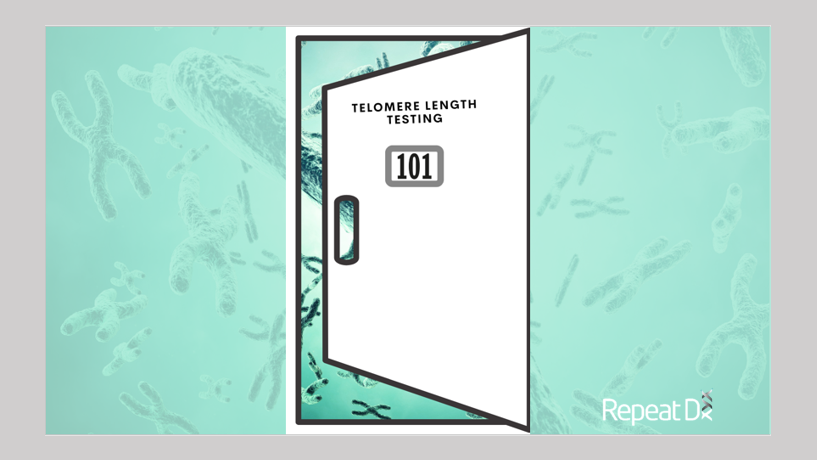
Telomeres?? Telomere length?? What in the world!
These are the typical reactions among the ones that come across the word “Telomere” for the first time. You may be looking into this blog with a specific purpose, for instance, you or a family member may have been diagnosed with a Telomere Disease, or you just popped in to learn about Telomere Length Testing. Here we provide an overview of telomere length measurement, including what it is, how the test is done, and its potential implications for physicians and patients.
Telomeres – the door that shields DNA
Telomeres protect chromosome tips from fraying (becoming too short), which would lead to human cell death. Otherwise, telomeres may fuse with each other to attempt repair. This fusion, in turn, can result in genetic abnormalities. Telomere length is a marker of cellular aging because cells lose a little telomere length each time they divide. So, the shorter the telomeres, the “older” the cells. In addition to cancer risk and association with other diseases, telomere length has also been linked with lifespan and overall health in population studies.
The length of telomeres is used as a biomarker for overall health in population research studies. What does that mean for an individual? Scientists and physicians are increasingly interested in using telomere testing to help diagnose disease progression and test novel treatment approaches in conditions such as Dyskeratosis Congenita, a rare inherited bone marrow failure disorder, and Pulmonary Fibrosis, a chronic lung disease.
Telomere length
What is a telomere, and why does its length matter? Telomeres are the protective caps at the end of each chromosome. They play a vital role in maintaining genomic stability. In humans, telomeres typically range in length from around 5000 base pairs to 15000 base pairs (5 to 15 kb). However, this number varies widely between individuals and depends on many factors, including age and health conditions.
To measure telomere length, a small blood sample is taken and sent to a laboratory. The results are reported as the “average telomere length,” which is the average number of base pairs in a telomere taken from all telomeres detected in the sample. Your Telomere Length measurement is then compared to reference ranges based on age to interpret the results.
As we age, our telomeres naturally become shorter. This process may be abnormally short to start with or may be accelerated by certain lifestyle choices or by telomere disorders called Telomere Biology Disorder (TBD).
Telomere length is used to determine the diagnosis and progression of Telomere Biology Disorders (TBD). The shorter the telomeres are, the more likely a person may develop disease symptoms that usually are associated with older age. Bone marrow failure, pulmonary fibrosis, and liver cirrhosis are three possible symptoms of TBD, with idiopathic pulmonary fibrosis being the most common manifestation seen in adults.
Currently, the extent of the TBD burden is not fully known. These conditions are challenging with symptoms that can be overlooked when they are relatively mild or have lengthy diagnostic journeys. However, an advocacy and support group for Telomere Biology Disorder called Team Telomere has published the second edition of the clinical guidelines to communicate the most up-to-date clinical diagnostic criteria as well as monitoring and treatment recommendations.
Telomere shortening

Telomere length is reduced with each cell division until it becomes too short for protecting the chromosome ends, at which point the cell dies or undergoes senescence (a state of permanent cell cycle arrest). Telomere shortening is a normal part of aging, but it is accelerated by lifestyle choices such as smoking or chronic stress. Telomere length measurements have been used to assess the effects of these lifestyle choices on health and disease risk in population research studies.
Telomere research

Currently, there is no cure for TBD, but there are dedicated monitoring and treatment approaches through research to improve outcomes. Patients and their care team can take steps to manage their symptoms and improve their quality of life to extend their healthspan and lives. Furthermore, recent discoveries in telomere research offer new hope for patients diagnosed with a Telomere Biology Disorder. Some current active clinical trials for “Telomere Diseases” can be found at https://www.clinicaltrials.gov/.
It is imperative to urge telomere research to develop potential treatments for Telomere Biology Disorders. The telomere test has played an essential role in helping researchers to develop these new treatments by providing a way to measure the effects of various interventions on telomere length.
Telomere testing can potentially improve our understanding of disease risk and progression, as well as guide treatment decisions. It could be used to study the effects of these lifestyle choices on telomere length and health. The test is also being explored to assess the risk of diseases such as cancer, heart disease, and Alzheimer’s disease.
Telomere test

Telomere tests should only be ordered by a health care provider as it is not currently recommended for routine screening in the general population. However, they may be useful for people at high risk for telomere-related diseases, such as those with a family history of bone marrow failure, pulmonary fibrosis or some types of cancer.
The most accurate telomere length testing is done using a blood sample.
Testing Types:
There are a few different ways to measure telomere length, and only two are available for clinical testing. The flow FISH method can measure the telomere length of individual cells from specific cell populations (leucocyte subsets). It is the most reproducible method (it can be replicated with consistent results). The PCR (polymerase chain reaction) method has several technical variations between laboratories, and it can measure the relative telomere length from blood DNA (total leucocytes).
PCR Telomere test – leukocyte telomere length
The Polymerase Chain Reaction test (PCR) takes a blood sample and measures the Telomere’s length of white blood cells. The technique collects all white blood cells, extracts their DNA, amplifies it, and counts the number of repetitive telomere DNA sequences in the amplified DNA pool. The length of telomeres in the sample is calculated by comparing the amount of telomere DNA to that of a single-copy gene.
Flow FISH Telomere test
The Flow FISH test is considered the gold standard for clinical telomere testing, as it is currently the most accurate and reproducible method for diagnostic purposes.
It comes in two assay versions: The 2-panel and the 6-panel assay.
The 6-panel Flow FISH assay includes measurements for B-cells, naïve and memory T-cells and NK cells, in addition to the total lymphocytes and granulocytes analyzed in the 2-panel assay. The 6-panel test provides a more comprehensive view of an individual’s Telomere status. Therefore, it is the preferred test among TBD physicians. This assay version has the highest clinical diagnosis sensitivity and specificity in the differential diagnosis of individuals with inherited bone marrow failure syndromes who may have an underlying TBD.
This test is done by first taking a blood sample and then staining the cells with fluorescent probes that specifically attach to Telomeres. The stained cells are then analyzed through a flow cytometer using lasers to quantify fluorescence and measure the Telomere’s length.
Testing implications
For different reasons, routine laboratory tests, such as blood counts, have always been a part of physicians’ diagnostics toolkit. However, regular clinical examinations and assessments are not enough to identify patients with short telomeres. Therefore, a more complex test may be needed to help physicians diagnose such disorders.
Physicians and patients should be aware of the potential risks and implications of undergoing testing and how they may impact their care for TBDs. Telomere testing is a relatively new door which is starting to open towards more varied applications in the medical field.
For physicians, telomere testing could be used to diagnose disease, in some cases, track disease progression, and guide treatment decisions. It could also help identify individuals at risk for developing certain complications. Results are interpreted in the specific medical context of the patient and often require medical family history if available.
The potential implications of telomere testing for physicians and patients regarding overall individual health are potentially significant and warrant further investigation.
If you are considering Telomere Length Testing, be sure to discuss it with your doctor to see if it is right for you.
Repeat Diagnostics is the pioneering clinical diagnostic laboratory using the flow FISH method. The flow FISH method represents a new standard in diagnostics, and the 6-panel assay for Telomere Length Testing is quickly becoming the number one choice for health care providers. Furthermore, Repeat Diagnostics is committed to the utmost quality of clinical service and to bringing the latest and most innovative technologies to physicians and patients.
Citations:
